File Backup Plan
A file backup plan is the most common plan type where files and folders are a backup source.
Note that if you intend to back up a whole media storage (i.e. a selected disk), use an image-based backup plan instead
This chapter covers the following topics:
- Select Backup Storage
- Plan Name
- Advanced Options
- Backup Source
- Advanced Filter
- Compression and Encryption Options
- Backup Consistency Check
- Schedule
- Retention Policy, GFS, Object Lock
- Pre / Post Actions
- Notification
- Summary
Create Backup Plan
To create a new file backup plan, click the Files icon in the horizontal menu bar.

The Backup Wizard starts.
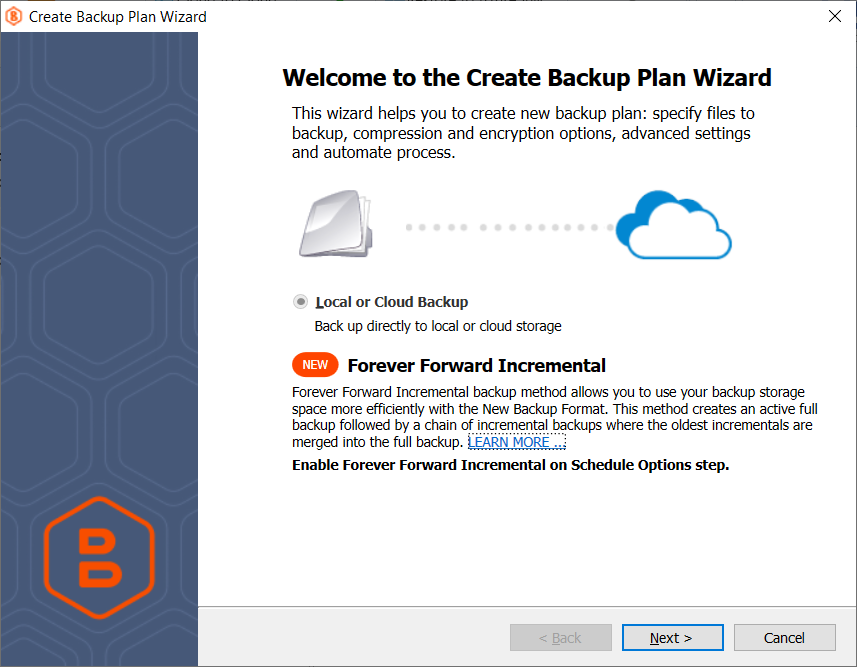
Select Backup Storage
Select a storage account for the backup plan from the list of available backup storage. If no storage is available, click Add new Storage Account.
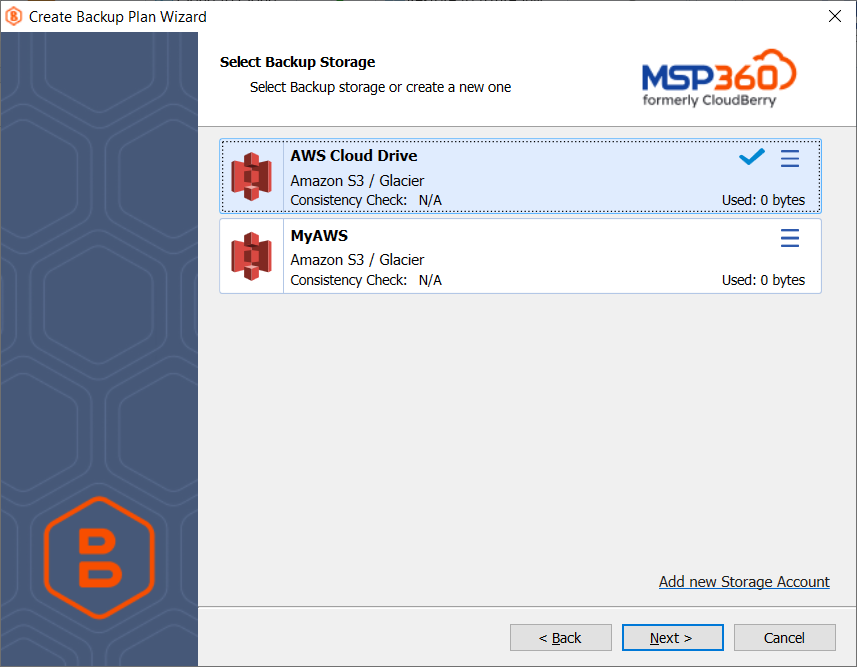
The backup plan configuration in the new backup format is always kept in a backup storage
Once you selected backup storage, click Next.
Plan Name
Specify the name for the backup plan.
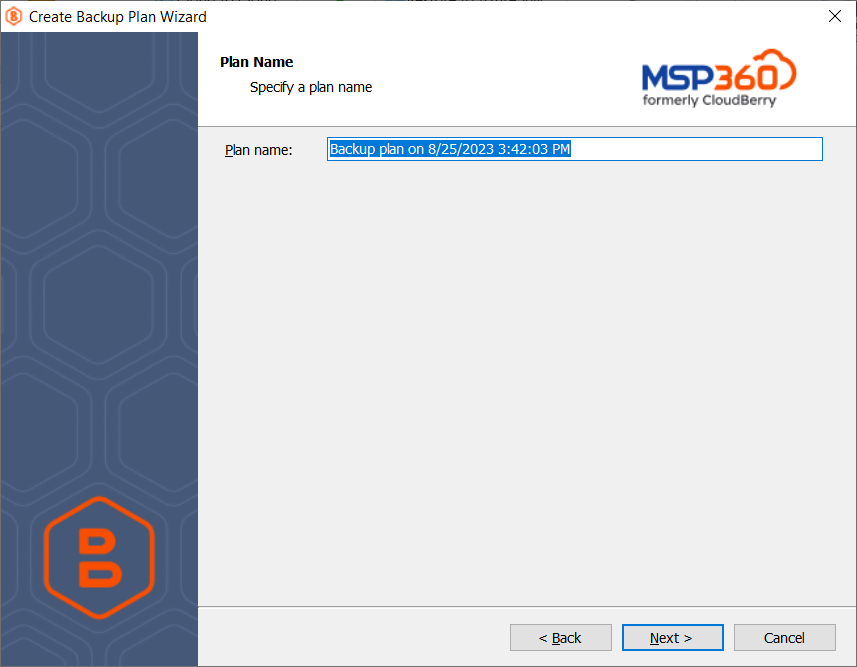
Click Next.
| Previous Step | Top | Next Step |
Advanced Options
Specify advanced options for the backup plan.
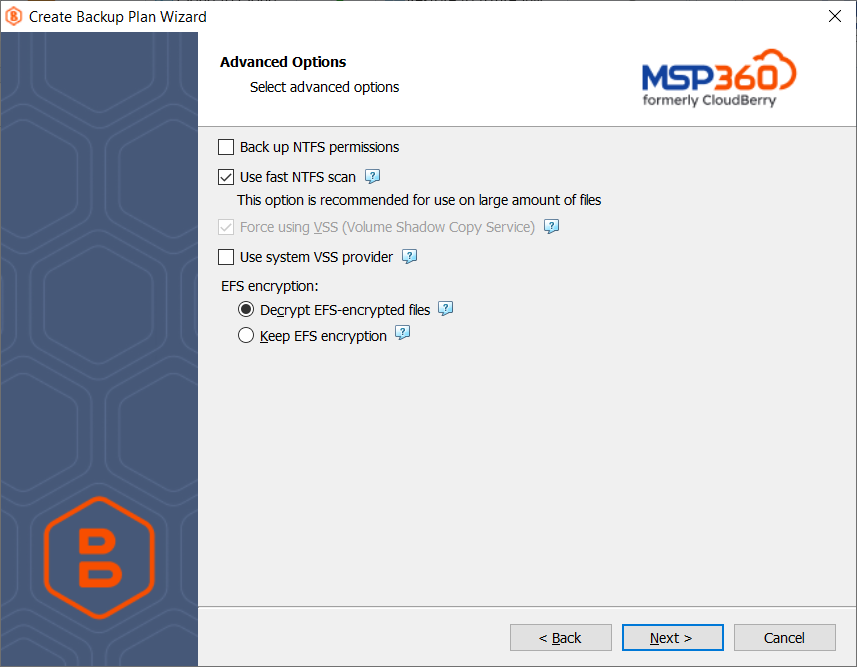
- Back up NTFS permissions. Select this check box to include current NTFS permissions in the backup plan
To learn more about NTFS permissions, refer to the NTFS permissions article
- Use fast NTFS scan. Select this check box to enable MSP360 proprietary file scanning and search mechanism. This mechanism is based on a file tree generation which allows faster data reading and faster backup procedure
Note that the Force Using VSS option is mandatory for fast NTFS scanning and is selected automatically
- Force using VSS. Select this check box to back up objects from a snapshot to avoid any access conflicts. This option is useful for forcible backup of files that are used by other processes at the moment of the backup plan run
To learn more about VSS, refer to the Volume Shadow Copy Service (VSS) article
VSS has some restrictions:
- VSS cannot be used to back up network files, such as network shares and mapped network drives
- VSS does not support FAT32
- Use system VSS provider. Select this check box in case you experience issues with a third-party VSS provider. Once the backup plan is run, the MSP360 Backup will use the system VSS provider forcibly.
EFS Encryption Options
Select the way to back up EFS-encrypted files. The two options are available:
- Decrypt EFS-encrypted files. With this option selected, EFS-encrypted files are first decrypted and then backed up. This option is set by default
- Keep EFS-encryption. With this option selected, EFS-encrypted files are backed up 'as is', as encrypted. Note that this option requires special attention since some issues decryption issues upon restore to a location other than the source computer may occur
Read more about EFS-ecnryption and how it works in Backup for Windows in the Backing Up EFS-encrypted Files chapter
Click Next.
| Previous Step | Top | Next Step |
Backup Source
Specify the content for the backup plan.

Advanced Options
To enable advanced options for the backup source, click the Advanced Options icon at the bottom of the Backup Wizard.
The following options are available:
- Add user profile. Use this option to include user folders in your backup plan. For example, "Documents", "Downloads", or _"Favorites".

- Add network share. Use this option if your backup source is located on a network share.
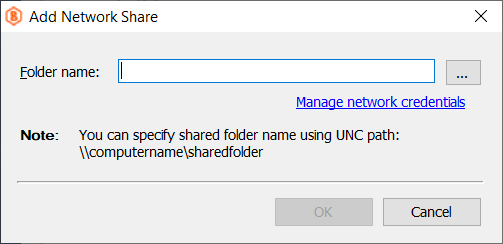
In this dialog, you can specify user credentials used to access the network share. Once you specified credentials, click Test to perform a test connection to a network share and make sure it can be accessed.
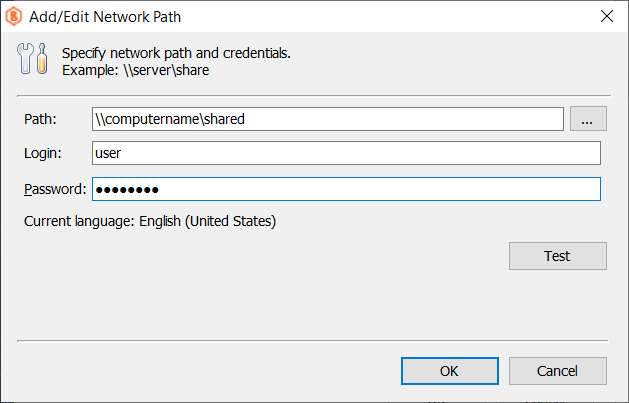
- Open in dialog. Select this option to open a new dialog window with a file tree
- Show legend. Select this option to learn about possible states of check boxes. See the legend below:
| Check State | Description |
|---|---|
 |
Neither the folder nor any of its contents are selected. |
 |
The folder is selected along with all of its contents (the backup will include all newly created subitems in this folder as well). |
 |
The folder is selected along with some of its contents (the backup will include all newly created subitems in this folder as well). |
 |
Some of the folder's contents are selected, but not the folder itself (the backup will only include explicitly selected subitems, and not newly created ones). |
Click Next.
| Previous Step | Top | Next Step |
Advanced Filter
Specify various criteria for backup source objects.
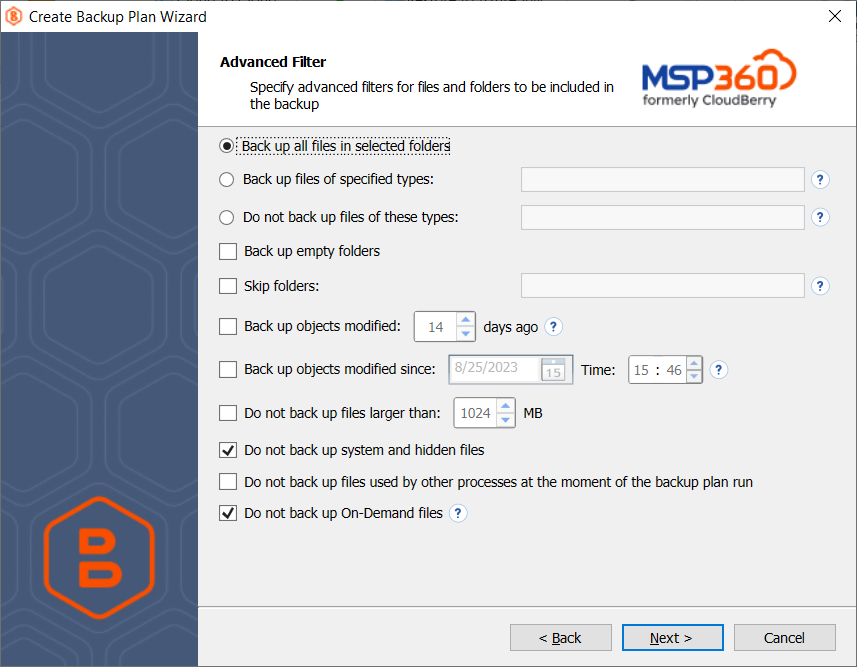
The following options are available:
- Back up all files in selected folders. Select this option to back up all files in folders, specified on the Backup Source step
- Back up files of these types. Select this option to back up files of certain types. The file type is detected by file extension. In the field to the right, specify the required file extensions. Use a semicolon to separate extensions
- Do not back up files of these types. Select this option to exclude files of certain types from the backup plan. The file type is detected by file extension. In the field to the right, specify file extensions to be excluded from the backup plan. Use a semicolon to separate extensions
- Back up empty folders. Select this check box to include empty folders in the backup plan
- Skip folders. In this field, specify folders to be excluded from the backup plan. Use a semicolon to separate folders
- Back up files modified (days ago). Select this check box, if you want to back up files, modified on a specific day. In the field to the right, specify the number of days from the last modification
- Back up files modified since. Select this check box if you want to include in the backup plan all files that have been modified after a point in time. In the fields to the right, specify the date and the time of file modification
- Do not back up files larger than (MB). Select this check box to limit the size of files for the backup plan. In the field to the right, specify the maximum file size
- Do not back up system and hidden files (selected by default). Select this check box to exclude files that have 'system' and/or 'hidden' attributes from the backup plan
- 'Do not back up files used by other processes at the moment of the backup plan run. Select this check box, if you want to exclude from the backup plan files that will be opened at the moment of the backup plan run
- Do not back up On-Demand files (selected by default). Select this check box to exclude On-Demand files from the backup plan.
To learn more about On-Demand files backups and OneDrive backup in general, refer to the OneDrive Backup chapter
Click Next.
| Previous Step | Top | Next Step |
Compression and Encryption Options
Specify compression and encryption options for the backup plan.
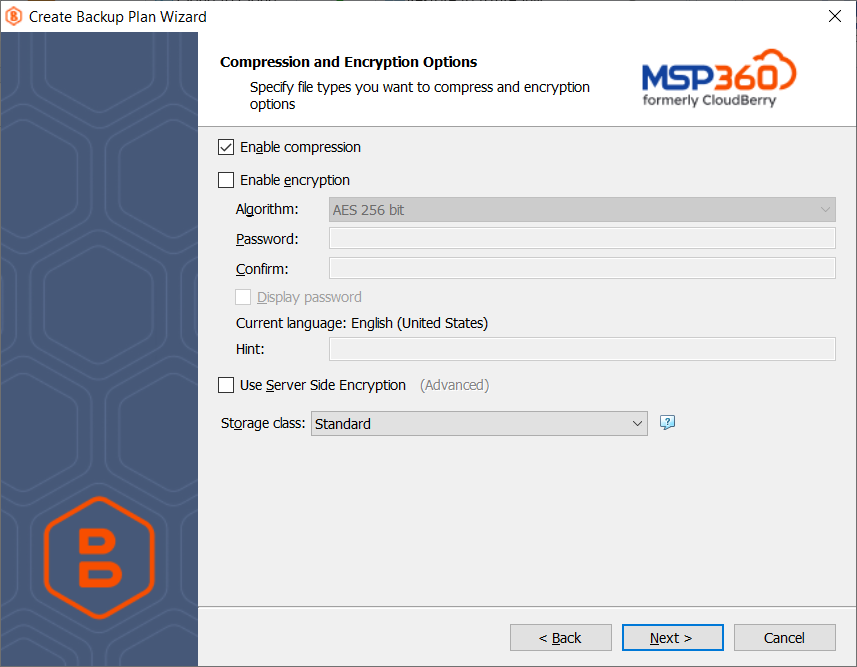
The following options are available:
- Select Enable compression check box to compress backup source contents for optimal backup storage space usage
- To protect your backup contents with encryption, select Enable encryption check box. MSP360 (CloudBerry) Backup supports AES encryption of 128, 192 and 256 bit key length. Select the appropriate key length in Algorithm drop-down menu
- Specify the encryption password in the Password field, then confirm the password in the Confirm field. To display the password, select Display password check box
Note that the encryption password will NOT be stored in the backup plan configuration for security reasons. Keep this password in a safe place to be able to restore the backup contents afterward
Particular Options for Amazon S3 Storage
If your backup storage destination is Amazon S3, the following particular options are available on this Backup Wizard step.
- Server-Side Encryption. Select this check box to enable encryption of your backup content on Amazon cloud storage.
If the Server-Side Encryption option is enabled, specify permissions a user is required to have to be able to access backup contents:
- Use the Amazon S3 Service master key. Select this option for Amazon S3 decrypts data for anyone who is granted permissions to access this backup content on the cloud
- Use the Amazon Key Management Service master key. Select this option for Amazon S3 decrypts data for anyone who has the permissions to access this object in the cloud along with permissions to use a specified master key.
To learn more about the Amazon master key, refer to the What is AWS Key Management Service article.
Amazon S3 Storage Classes
If your backup storage destination is Amazon S3, select the S3 storage class for the backup plan:
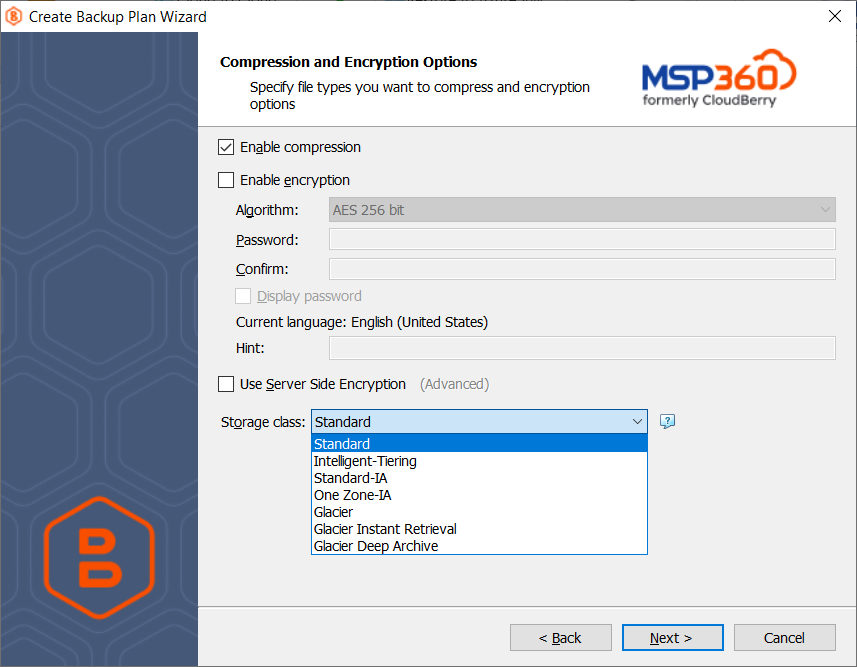
Using different storage classes for different backup needs to optimize your storage costs.
Learn more about Amazon S3 storage classes here
Microsoft Azure Blob Storage
If your backup storage destination is Microsoft Azure, select the required Azure Blob Storage.
The following options are available:
- Archive Blob Storage. This is a low-cost storage option for infrequently accessed data. As opposed to hot and cool storage tiers, retrieving data from an Archive Blob Storage may take up to several hours
- Cool Blob Storage. The cool storage tier has lower storage costs and higher access costs compared to hot storage. This tier is intended for data that will remain in the cool tier for at least 30 days.
Note that this feature is only supported for General Purpose v2 Azure accounts. If you are using another kind of account, you need to upgrade your account to be able to use this feature
Be aware of the additional charges and increased blob access rates after your Azure account upgrade
To learn more about the difference between Azure storage tiers, refer to the Azure Blob Storage - Hot, cool, and archive storage tiers article at docs.microsoft.com.
Click Next.
| Previous Step | Top | Next Step |
Backup Consistency Check
Specify if the full consistency check is required for this backup plan.
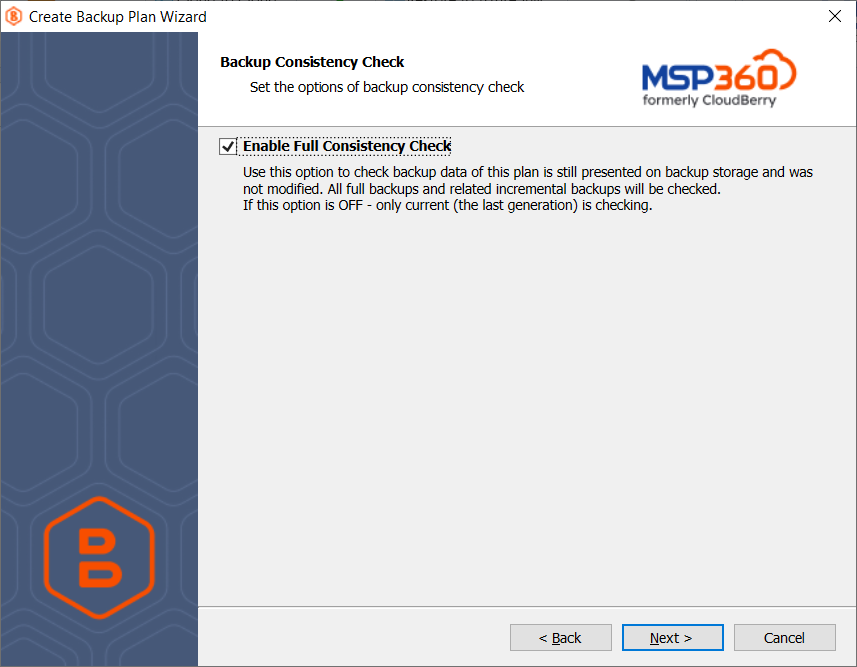
To learn more about consistency checks, refer to the Consistency Checks chapter
Click Next.
| Previous Step | Top | Next Step |
Schedule
Specify the backup plan schedule options.
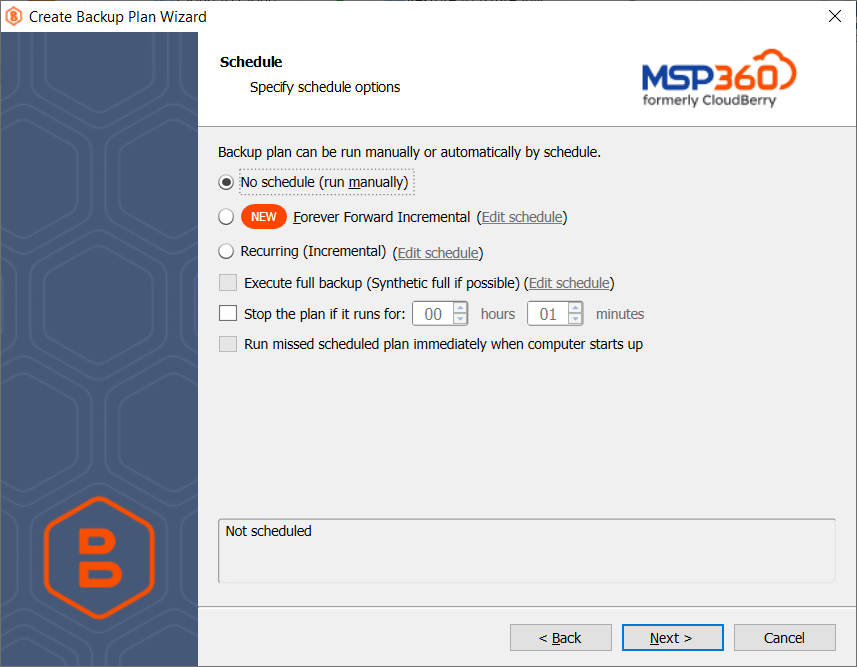
The following options are available:
- Select the No schedule option to run the backup plan manually
- Select the Forever Forward Incremental option to apply the Forever Forward Incremental (FFI) schedule
Once you select this option, specify the FFI schedule for the backup plan:
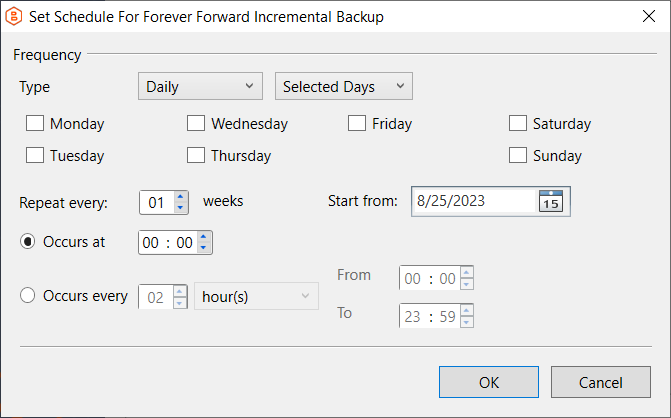
- Select the Recurring option to execute the backup plan on a periodic basis. Once you select this option, specify the schedule for incremental backups for this backup plan:
Specify if the backup plan runs on a daily or monthly basis, then specify the schedule: select weekdays and set the start time for backup.
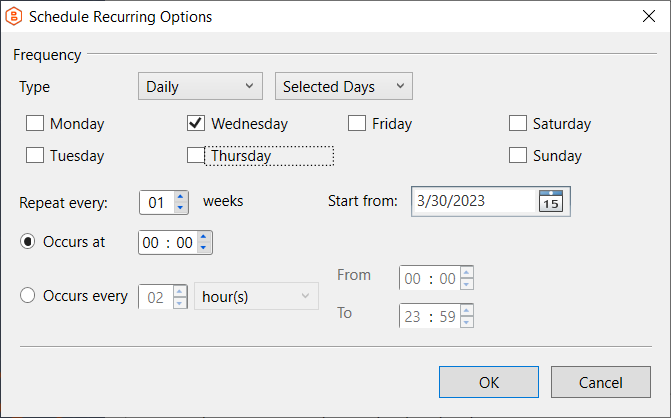
The Repeat Every option allows configuring flexible schedule according to your requirements. The example on the drawing shows the incremental backup schedule executed every week on Wednesdays starting from 30 March 2023. You can create a schedule with multiple days of the week and specify the desired period measured in weeks or months.
- To run the full backup (synthetic full for supported backup storage) on a periodic basis, select the Execute full backup (synthetic full if possible) check box, then specify the schedule:
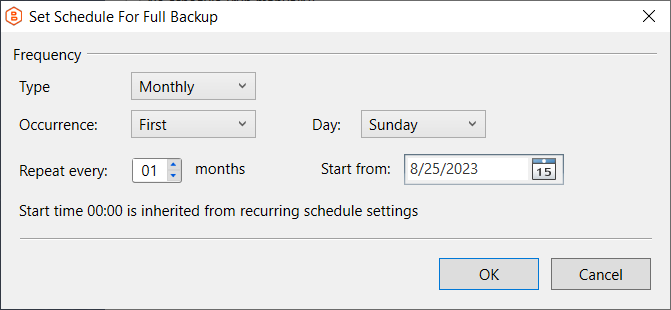
Note that the starting time for full or synthetic full backup run is inherited from incremental schedule settings to avoid simultaneous incremental and full backups
Note that the plan running controls depend on the schedule settings. So, if a full backup schedule is specified, the plan running controls on the Backup Plans tab are available:
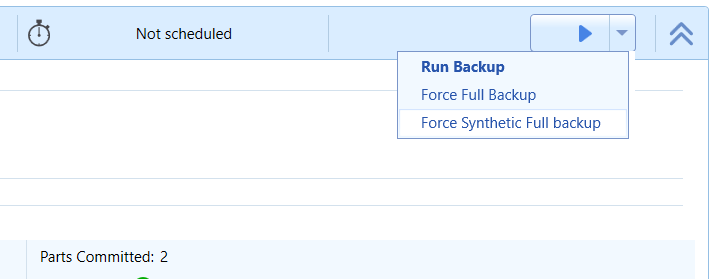
If no full backup schedule is specified, Force full backup or Force Synthetic backup options are unavailable

- To set the time limit for plan execution, select Stop the plan if it runs for check box, then specify the backup plan duration limit
- To run the backup plan after the computer is on in case the backup plan run has been missed, select Run missed scheduled backup immediately when computer starts up check box
Click Next.
| Previous Step | Top | Next Step |
Retention Policy, GFS and Object Lock
Specify the retention policy settings for the backup plan.
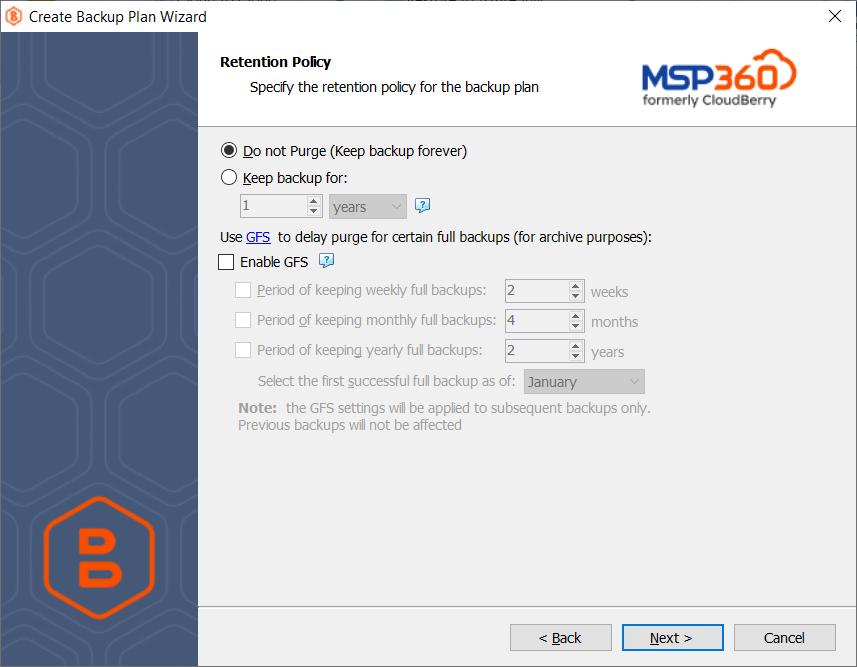
The following options are available:
- Do not purge. Select this option to keep all your backup runs
- Keep backup for. Select this option to limit the period while backup contents are kept in the backup storage, then specify the period
Learn more about the retention policy in the Retention Policy chapter chapter
To apply the GFS retention policy for the backup plan, select the Enable GFS check box, then customize the GFS retention policy by enabling the required keeping periods (weekly, monthly and yearly purge delays).
To learn more about the GFS retention policy, refer to the About GFS chapter
If backup data is required to be locked, enable the Object Lock (Immutability) check box.
To learn more about the Object Lock (Immutability) feature, refer to the Object Lock (Immutability) chapter
Retention Policy with Forever Forward Incremental Schedule
If on the Schedule step you selected the Forever Forward Incremental schedule, the Retention Policy step has different settings.
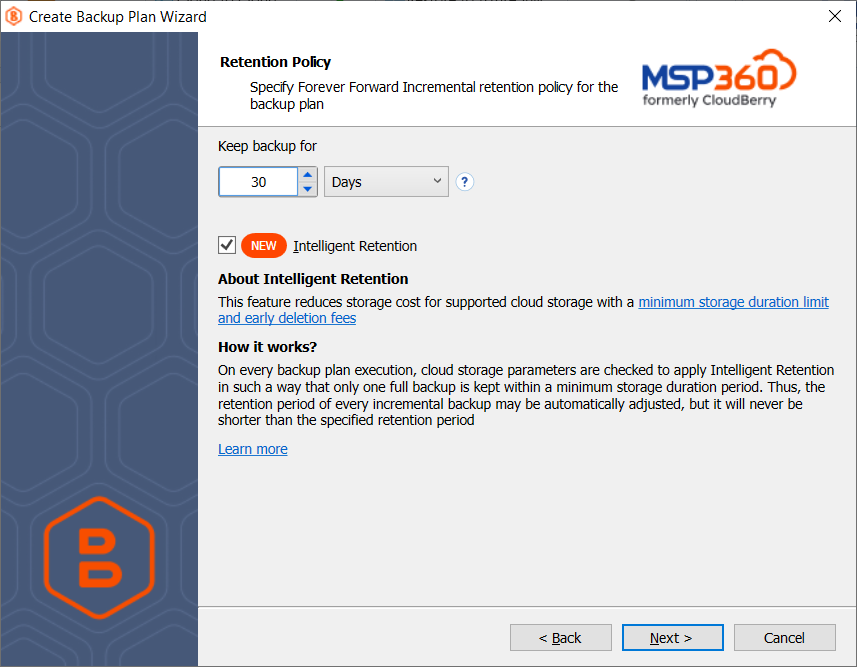
The Keep backup for value defines the period Restore Points with the Forever Forward Incremental schedule are kept. If their retention period expires, these Restore Points are merged into a full backup (with Forever Forward Incremental only one full backup is kept on backup storage).
Enable the **Intelligent Retention option (highly recommended). Intelligent Retention is based on the following approach: each time the backup plan is executed, backup storage parameters are checked and the retention period for the full backup is set in such a way that it is kept on backup storage for the minimum period based on the storage provider data deletion conditions. Analysis of backup storage parameters is performed automatically, you do not need to do anything.
Learn more about Intelligent Retention in the Intelligent Retention chapter
Click Next.
| Previous Step | Top | Next Step |
Pre-/Post Actions
Customize actions before and/or after the backup plan run.
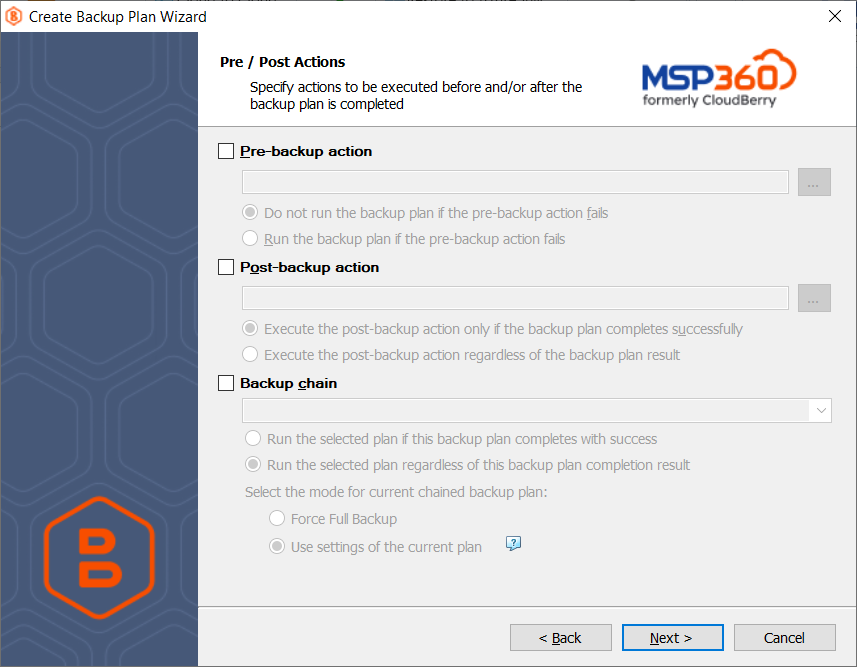
Custom Scripts
You can execute custom scripts before or after running the backup plan.
- To specify the script execution before the backup plan starts, select the Pre-backup action check box, then specify the path to the script in the field below. To open a standard Windows dialog box, click the ... button
- Select the pre-backup script execution options:
- Exit backup plan if pre-backup action failed. Select this option to cancel the backup plan in case the specified script fails
- Continue backup plan if pre-backup action failed. Select this option to run the backup plan regardless of the specified script execution results
- To specify the script execution after the backup plan terminates, select the Post-backup action check box, then specify the path to the script in the field below. To open a standard Windows dialog box, click the ... button
- Select the post-backup script execution options:
- Execute post-backup action only if backup plan has been successfully completed. Select this option to execute the post-backup script only in case of a backup plan success
- Execute post-backup action regardless of the backup result. Select this option to execute the post-backup script in any case
Note that an absolute path to a script is required, i.e. if you specify the path to a script, it should be as follows:
c:\scripts\prebackup-script.bat
In case the absolute path to a script file is not specified, the default directory for the script is "C:\Windows\System32"
The following script formats are supported: EXE, COM, BAT, CMD, or PIF
Mind that MSP360 (CloudBerry) Backup supports EXE files have several restrictions: EXE files must not use GUI and must close automatically upon termination.
For example, the following script will not succeed:
cmd.exe /F:ON
In this case, this command must be used with the /C parameter, as shown below:
cmd.exe /F:ON /C
The same restriction applies to applications executed by PowerShell scripts:
PowerShell.exe Start-Process cmd.exe exit
It is highly recommended to perform a test run for the created backup plan to ensure that MSP360 (CloudBerry) Backup properly executes specified scripts
Backup Plan Chains
In case you need to run another backup or restore plan once the backup plan is finished, use the Backup Chain feature. To create a backup chain, select the Backup chain check box, then select a backup or restore plan to be chained.
- Execute the specified backup plan only if backup plan has been successfully completed. Select this option to execute the chained backup plan only in case of a backup plan success
- Execute the specified backup plan regardless of the backup result. Select this option to execute the chained backup plan in any case
- In case you chained a backup plan, you can enable the full backup for it regardless of the contents in the backup storage. To do this, select the Force full backup for the chained plan.
To learn more about the full backup type, refer to the Full Backup Explained chapter
Click Next.
| Previous Step | Top | Next Step |
Notification
Specify notification settings.

- To receive the notification after the backup plan completion, select the I want to receive notification email when backup completes check box.
- Select When backup fails option if you want to receive the notification message only in case of the backup plan failure
- Select the In all cases option if you want to receive the notification message in any case.
- In the fields Username, Email, Email subject specify the notification email details. You can specify one or more email recipients. Separate them by semicolon or comma, the recipient name (one for all of them). The email subject can also contain any of the following variables:
- %COMPUTER_NAME%. Displays the instance name on which the backup plan was executed
- %RESULT%. Displays the result of the backup plan. Possible values: Success, Finished with warnings, Failed
- %PLAN_NAME%. Displays the name of the backup plan.
- If you want to use own SMPT server for notification emails, select the I want to use my SMTP server for email notifications check box, then specify the settings for the SMTP server
- If you want the backup plan record to be added to Windows Event Log, select the Add entry to Windows Event Log when backup completes check box
- Select When backup fails option if you want to receive the notification message only in case of the backup plan failure
- Select the In all cases option if you want the entry to be put in Windows Event Log in any case.
Click Next.
| Previous Step | Top | Next Step |
Summary
Review the configuration of the backup plan.
Click Next to proceed to the last wizard page.
Select the Run backup now check box to execute the backup plan immediately.
If you want to run the backup plan later, click Finish.
Edit a Backup Plan
To edit the backup plan, proceed as follows:
- Switch to the Backup Plans tab.
- Open the plan to edit, expand it, then click Edit.

- Follow the Backup Wizard steps to save the backup plan configuration.
Delete a Backup Plan
To delete the backup plan, proceed as follows:
- Switch to the Backup Plans tab.
- Open the plan to delete, expand it, then click Delete.

- Click Yes to confirm the backup plan deletion.

